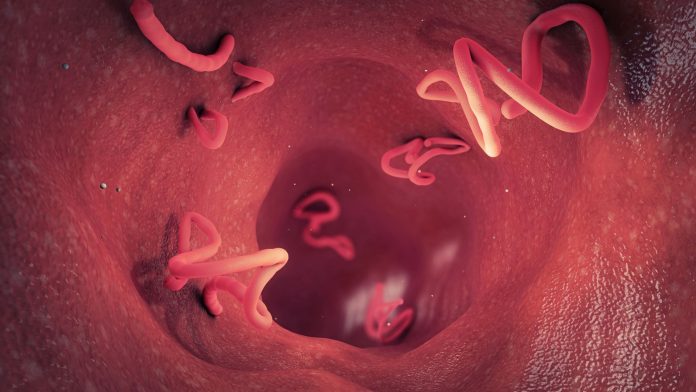
A novel investigation has indicated that a range of widely utilised tapeworm drugs may also work as an effective COVID-19 treatment.
The research, conducted by Professor Kim Janda, PhD, the Ely R. Callaway, Jr. Professor of Chemistry and director of the Worm Institute for Research and Medicine at Scripps Research, has successfully identified a compound that can potentially be employed as a COVID-19 treatment.
The compound, which was inspired by medications that have been widely prescribed to treat tapeworms, is part of a class of molecules named salicylanilides and has been demonstrated to provide two-pronged effectiveness against COVID-19 in laboratory studies.
The research is published in the journal ACS Infectious Disease.
A new COVID-19 treatment hiding in plain sight
Salicylanilides were discovered around 70-years ago in Germany, initially being utilised to treat worm infection in cattle, with iterations of the drug, such as niclosamide, used today to treat tapeworm in animals and humans. Additionally, this class of drugs have been examined for anti-cancer and antimicrobial properties.
Janda said: “It has been known for 10 or 15 years that salicylanilides work against certain viruses. However, they tend to be gut-restricted and can have toxicity issues.”
In mouse and cell-based tests, the pioneering compound overcomes both issues of toxicity and being gut-restricted, demonstrating to be an antiviral and an anti-inflammatory drug-like compound, comprising qualities that make it bode well for use in pill form.
The new modified salicylanilide compound was just one of 60 that Janda designed for a previous project; when the SARS-CoV-2 virus became a global pandemic, he started screening this old collection of compounds due to them possibly having antiviral properties. Initially, the compounds were tested in cells with collaborators from Sorrento Therapeutics and The University of Texas Medical Branch, and after yielding promising results, moved on to rodent studies.
From this process, the team identified one compound that stood out among the rest that they dubbed “salicylanilide 11”. This potential COVID-19 treatment varies from traditional tapeworm medicines in crucial ways, as it is proficient in passing beyond the gut and can be absorbed into the bloodstream without toxicity.
Janda Said: “Niclosamide is basically digestive-track restricted, and that makes sense because that’s where parasites reside. For that reason, simple drug repurposing for a COVID treatment would be counterintuitive, as you want something that is readily bioavailable yet does not possess the systemic toxicity that niclosamide has.
“About 80 per cent of salicylanilide 11 passed into the bloodstream, compared to about 10 per cent of the antiparasitic drug niclosamide, which has recently entered clinical trials as a COVID-19 treatment.”
Analysing salicylanilide 11
Comprehensive experiments signified that salicylanilide 11 influenced coronavirus infections in two ways. First, it impeded how the virus deposited its genetic material into infected cells in a process called endocytosis, which requires the virus to form a lipid-based packet enveloping viral genes. Usually, the packet permeates the infected cell and dissolves, causing the infected cell’s protein-building machinery to read it and create new viral copies. However, salicylanilide 11 has been shown to stop the dissolution of the packet.
Janda explained: “The compound’s antiviral mechanism is the key. It blocks the viral material from getting out of the endosome, and it just gets degraded. This process does not allow new viral particles to be made as readily.
“Importantly, because it acts inside cells rather than on viral spikes, questions about whether it would work in new variants like Delta and Lambda aren’t a concern. This mechanism is not dependent on the virus spike protein, so these new variants coming up aren’t going to relegate us to finding new molecules as is the case with vaccines or antibodies.”
Secondly, salicylanilide 11 aided in reducing toxic inflammation, a characteristic that could be vital in mitigating the respiratory distress that is commonly displayed in severe COVID infections. The compound effectively reduced levels of the signalling protein interleukin 6, a known cause of inflammation in the advanced stages of COVID-19.
Salicylanilide 11 has already been licensed by pharmaceutical company Sorrento Therapeutics to treat Clostridioides difficile – a bacterial infection – with this new study signifying its potential benefits to the pharma world as a new COVID-19 treatment.
“Salicylanilide 11 actually was placed on the back burner in my laboratory against C. difficile because it’s not as gut-restricted as we would like it to be,” Janda said. “But salicylanilide 11 has got a lot of really positive things going for it as a potential therapeutic for COVID.”
























